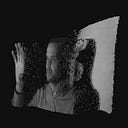Imaging: Event-Based Imager vs. Global Shutter Imager?
Event imaging
Global Shutter
A team of researchers from Czech Institute of Informatics, Robotics and Cybernetics, Czech Technical University in Prague, and University of Defence, Brno, Czech Republic, publishes an interesting MDPI paper “ Experimental Comparison between Event and Global Shutter Cameras”
“ We compare event-cameras with fast (global shutter) frame-cameras experimentally, asking: “What is the application domain, in which an event-camera surpasses a fast frame-camera?” Surprisingly, finding the answer has been difficult.
Our methodology was to test event- and frame-cameras on generic computer vision tasks where event-camera advantages should manifest. We used two methods: (1) a controlled, cheap, and easily reproducible experiment (observing a marker on a rotating disk at varying speeds); (2) selecting one challenging practical ballistic experiment (observing a flying bullet having a ground truth provided by an ultra-high-speed expensive frame-camera). The experimental results include sampling/detection rates and position estimation errors as functions of illuminance and motion speed; and the minimum pixel latency of two commercial state-of-the-art event-cameras (ATIS, DVS240). Event-cameras respond more slowly to positive than to negative large and sudden contrast changes. They outperformed a frame-camera in bandwidth efficiency in all our experiments. Both camera types provide comparable position estimation accuracy. The better event-camera was limited by pixel latency when tracking small objects, resulting in motion blur effects. Sensor bandwidth limited the event-camera in object recognition. However, future generations of event-cameras might alleviate bandwidth limitations.
We tested two event-cameras: iniVation (Zurich, Switzerland) DVS240 (DVS240 in short), which is an evolved version of the popular DAVIS240, and Prophesee (Paris, France) ATIS HVGA Gen3 (ATIS in short).”
by Ondřej Holešovský, Radoslav Škoviera, Václav Hlaváč, and Roman Vítek.
When comparing the following data, especially the low-light part of it, please note that Basler camera has about 16 times smaller pixel area than the other 3 cameras. Also note that the power efficiency was not a part of this research.
Maybe its worth mentioning that the compared Basler runs a Python 300 sensor (this sensor is around for about 10 years…) on USB3.
“ In future work, (a) we aim to research event/frame-camera performance in high dynamic range scenes; and (b) use event-cameras in robotic perception tasks requiring fast feedback loops.”
Originally published at http://image-sensors-world.blogspot.com.
